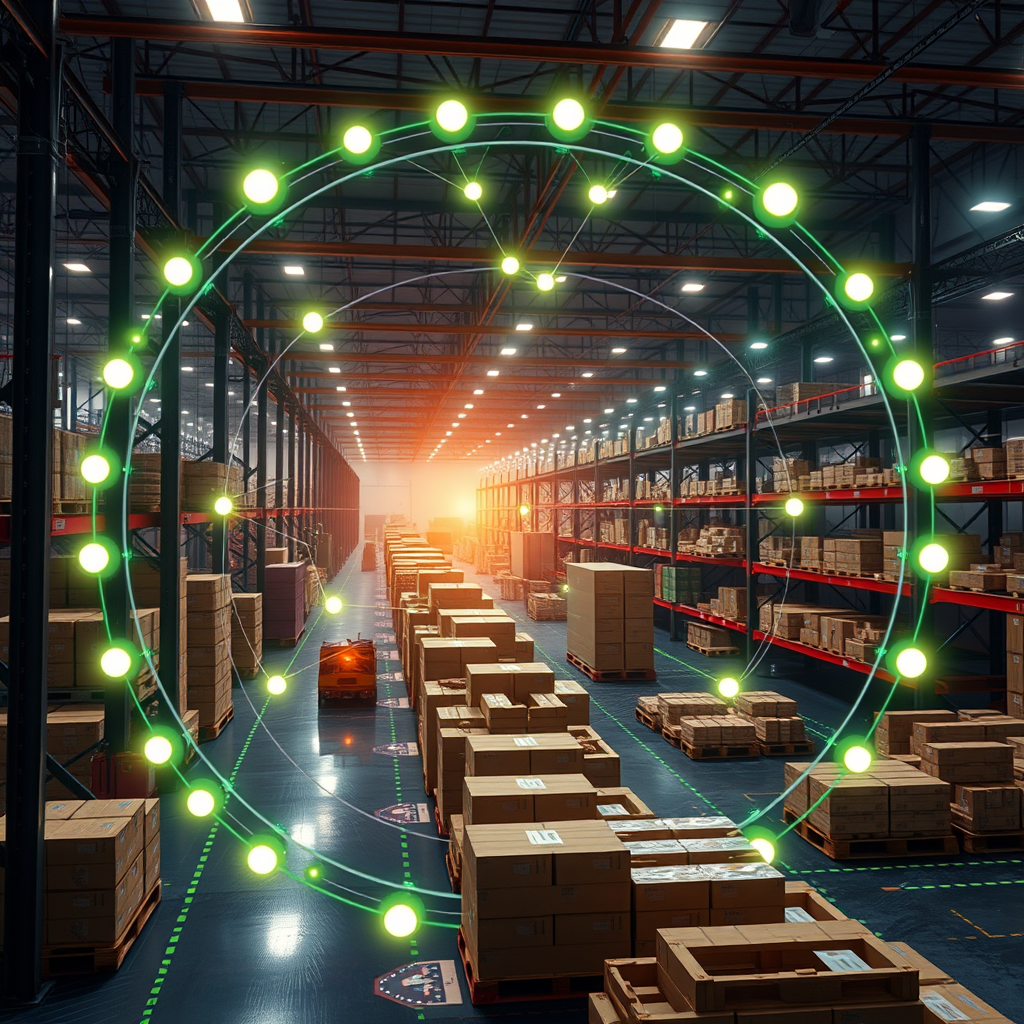This content originally appeared on HackerNoon and was authored by Thomas Cherickal
\
The Need for Innovation in the Global Supply Chain Industry
The Urgent Need for Supply Chain Resilience
The global supply chain industry faces unprecedented challenges, with disruptions becoming increasingly common. These disruptions, ranging from natural disasters and cyberattacks to labor shortages and transportation bottlenecks, highlight the urgent need for more resilient and adaptive supply chain solutions. The COVID-19 pandemic, in particular, exposed the fragility of global supply networks, revealing vulnerabilities in the face of sudden disruptions.
Navigating Ongoing Global Pressures
In addition to disruptions, the supply chain industry must also navigate ongoing global pressures. Geopolitical conflicts create tariffs and export restrictions, complicating international logistics. Simultaneously, inflationary pressures across the supply chain put a strain on profit margins and impact consumer prices.
The Growing Importance and Complexity of Supply Chain Management
The global supply chain management market has grown significantly, reflecting increased investment in technologies and services to navigate these complex global networks. This growth underscores the increasing importance of supply chain management for business success and competitive advantage. Modern supply chains are geographically dispersed and involve numerous stakeholders, demanding sophisticated coordination and real-time visibility. The industry must balance efficiency with resilience, sustainability with cost-effectiveness, and speed with quality control.
Technological Advancements Transforming the Industry
Businesses are seeking solutions to improve visibility, reduce risks, and enhance operational efficiency in their supply chains. Companies are investing in advanced technologies like AI, IoT, and blockchain to gain real-time insights and automate decision-making. There is a growing focus on building agile and responsive supply chains that can adapt to changing market conditions and customer demands. These cutting-edge technologies, from predictive analytics to robotics, are transforming supply chain operations, promising more resilient, efficient, and sustainable solutions for the future.
Decentralized Autonomous Supply Chain: A Blockchain-Powered Revolution

Building a Unified Digital Ecosystem with Blockchain
A decentralized autonomous supply chain powered by blockchain technology offers a revolutionary solution to modern supply network challenges. This approach leverages blockchain's security, transparency, and immutability for trustless supply chain operations, enhancing resilience and efficiency. This system creates a fully digital, end-to-end supply chain ecosystem, integrating all participants onto a single platform. This enables seamless information flow, reducing delays and errors associated with traditional, siloed systems. Every transaction is tracked on an immutable blockchain ledger, creating an unalterable record of the entire supply chain. This enables real-time visibility into goods at every stage, ensuring data integrity and a single source of truth.
Harnessing the Power of Automation
Smart contracts automate various supply chain processes, enhancing efficiency and reducing human error. They automatically trigger actions when predefined conditions are met, streamlining operations and minimizing disputes. Smart contracts can streamline numerous processes, including order fulfillment, payment processing, and dispute resolution. They automate tasks like matching purchase orders with invoices, triggering payments, and initiating dispute resolution.
Integrating IoT and AI for Enhanced Visibility and Optimization
The system integrates IoT devices, providing real-time data on product conditions and locations. RFID tags, GPS trackers, and sensors feed data into the blockchain, creating a digital twin of the physical supply chain. This real-time data enables proactive management of supply chain operations. Furthermore, AI and machine learning algorithms analyze data to optimize operations and predict potential issues. They identify patterns and trends, leading to informed decision-making and strategic planning.
Creating a More Efficient, Transparent, and Resilient Future
This solution addresses key pain points in current systems, offering a comprehensive approach to modern challenges. It tackles issues of transparency, efficiency, and risk management through end-to-end visibility and automation. This solution offers unprecedented transparency, efficiency, and resilience, positioning businesses to thrive. Blockchain technology builds trust, automation enhances efficiency, and increased resilience helps navigate uncertainties.
The Power of a Decentralized Autonomous Supply Chain

Smart Contract Automation: Driving Efficiency and Reducing Errors
Smart contracts, written in languages like Go or Kotlin, automate various supply chain processes, enhancing efficiency and reducing human error. These self-executing contracts trigger actions when predefined conditions are met, such as releasing payment upon confirmed delivery. This automation leads to reduced processing times, minimizes disputes, and enhances overall supply chain efficiency. For example, smart contracts can streamline order fulfillment, payment processing, and dispute resolution, significantly reducing administrative overhead and improving accuracy.
Real-Time Visibility and Traceability with IoT Integration
This system integrates IoT devices throughout the supply chain, providing real-time data on product conditions and locations. RFID tags, GPS trackers, and environmental sensors continuously feed data into the blockchain, creating a digital twin of the physical supply chain. This real-time monitoring of product quality, location, and handling conditions enhances traceability, improves quality control, and allows for the proactive management of supply chain operations.
Leveraging AI and Machine Learning for Intelligent Optimization
AI and machine learning algorithms analyze the vast amounts of data generated within the supply chain to optimize operations and predict potential issues. This data analysis allows for identifying patterns and trends, leading to more informed decision-making and strategic planning. AI can also automate complex tasks, such as predicting demand fluctuations, identifying potential disruptions, and suggesting optimal routing, which significantly enhances the agility of the supply chain.
Digital Twins: Unlocking Advanced Simulation and Optimization
Digital twins of physical assets and processes, created through the integration of IoT and AI, allow for advanced simulation and optimization of supply chain operations. Businesses can test different scenarios and strategies in a risk-free environment, enabling real-time monitoring and predictive maintenance capabilities. This leads to reduced downtime and an extended lifespan of assets.
Incentivizing Collaboration and Transparency with a Token Economy
A token economy incentivizes participation and good behavior in the network, aligning the interests of all stakeholders. Participants are rewarded for actions that benefit the network, which encourages collaboration and continuous improvement. This system drives overall efficiency and effectiveness within the supply chain ecosystem.
A More Transparent, Efficient, and Resilient Supply Chain for a Competitive Edge
This solution addresses key pain points in current supply chain systems, offering a comprehensive approach to modern challenges. Through end-to-end visibility, automated processes, and proactive management, businesses gain unprecedented transparency, efficiency, and resilience. This translates to stronger trust among partners, faster issue resolution, significant cost savings, improved service levels, and a greater ability to navigate uncertainties.
\
Revolutionizing Supply Chains: Unlocking Unprecedented Value with a Decentralized Approach

\
Enhanced Security and Trust through Immutable Records
The blockchain provides an immutable record of every supply chain event, ensuring secure logging of transactions and movements. This inherent transparency prevents tampering and fraud, fostering trust among participants. Stakeholders gain end-to-end visibility, tracking products from raw material sourcing to final delivery. This comprehensive overview allows for the identification of bottlenecks and areas for improvement.
Real-Time Insights for Improved Efficiency and Responsiveness
Real-time tracking capabilities provide immediate access to product information, enabling quick responses to issues and improved decision-making. This agility allows businesses to proactively mitigate potential disruptions, ensuring a more resilient supply chain.
Streamlined Processes and Reduced Costs through Automation
Smart contracts automate manual processes, reducing human error and processing time. This streamlines operations and speeds up transactions, leading to increased efficiency and reduced costs. Additionally, AI-driven analytics optimize inventory levels, routing, and resource allocation, further enhancing operational efficiency and cost savings.
Fostering Collaboration and Informed Decision-Making
The decentralized nature of this solution provides a shared, trusted source of information, eliminating data discrepancies and fostering collaboration among stakeholders. Access to accurate, real-time data enables informed decision-making and efficient coordination among supply chain partners.
Driving Ethical and Sustainable Practices
Blockchain technology enables the verification of ethical and sustainable practices, combating greenwashing and building consumer trust. The transparent tracking of materials and labor practices supports corporate social responsibility initiatives and ensures ethical sourcing throughout the supply chain.
A More Transparent, Efficient, and Ethical Supply Chain for the Future
By combining the power of blockchain, AI, and IoT, this decentralized approach revolutionizes traditional supply chain models. The result is a more transparent, efficient, and ethical supply chain that benefits businesses, consumers, and the planet.
Architecting a Decentralized Autonomous Supply Chain: Key Technological Considerations

\
Selecting the Right Blockchain Platform
Hyperledger Fabric or R3 Corda are suitable blockchain platforms for enterprise-grade performance. These platforms offer high throughput, scalability, and robust privacy features. They support permissioned networks, which are crucial for maintaining control and security within enterprise supply chains.
Ensuring Efficient Consensus Mechanisms
Practical Byzantine Fault Tolerance (PBFT) or Raft consensus algorithms are preferred for their efficiency. These algorithms provide quick finality and high transaction throughput. They are also more energy-efficient than proof-of-work mechanisms used in public blockchains.
Choosing the Optimal Smart Contract Language
Go (Golang) is used for Hyperledger Fabric smart contracts, while Kotlin is preferred for Corda smart contracts. These languages offer strong typing and good performance for complex business logic, making them well-suited for demanding supply chain operations.
Seamless IoT Integration for Real-Time Data
The system must support various IoT protocols such as MQTT and CoAP to ensure compatibility with diverse sensors and devices. It needs to handle large volumes of data from these various sensor types efficiently. Edge computing may be necessary for processing data closer to the source before blockchain integration.
Leveraging AI and Machine Learning for Optimization
TensorFlow or H2O.ai can be used for predictive analytics and optimization within the supply chain. These platforms offer powerful tools for processing large datasets and can integrate with blockchain data for real-time analysis and decision-making.
Integrating Digital Twin Technology for Enhanced Visibility
Integration with platforms like Azure Digital Twins is crucial for creating a digital representation of the physical supply chain. This allows for virtual modeling and simulation of supply chain processes. It also enables predictive maintenance and optimization of physical assets.
\
The Top Twenty Use-Cases with Sources of Revenue

End-to-End Product Traceability
End-to-end product traceability allows companies to track items from raw materials to final delivery. It enhances transparency, reduces counterfeiting, and improves recall efficiency. This service provides real-time visibility into the supply chain, boosting consumer trust and regulatory compliance.
Revenue: Subscription fees for traceability services \n Market size: $3.2 billion by 2023 [2]
Automated Customs Clearance
Automated customs clearance streamlines the process of moving goods across international borders. It reduces paperwork, minimizes human errors, and accelerates the clearance process significantly. This system integrates with blockchain to ensure data integrity and provide a transparent audit trail.
Revenue: Transaction fees for each clearance \n Market size: Potential savings: Up to 80% reduction in processing time [3]
Smart Contract-based Procurement
Smart contract-based procurement automates the entire purchasing process, from requisition to payment. It enforces predefined rules, ensuring compliance and reducing the risk of fraud or errors. This system can handle complex agreements, including multi-party contracts and conditional terms.
Revenue: Percentage of cost savings achieved \n Market size: Average savings: 5-10% of procurement spend [4]
IoT-Enabled Cold Chain Monitoring
IoT-enabled cold chain monitoring uses sensors to track temperature-sensitive goods throughout transportation. It provides real-time alerts for temperature deviations, ensuring product quality and regulatory compliance. This system integrates with blockchain to create an immutable record of environmental conditions.
Revenue: Subscription for real-time monitoring services \n Market size: $8.2 billion by 2025 [5]
AI-Driven Demand Forecasting
AI-driven demand forecasting uses machine learning algorithms to predict future demand with high accuracy. It analyzes historical data, market trends, and external factors to optimize inventory levels. This system can adapt to sudden changes in demand patterns, improving supply chain resilience.
Revenue: Licensing fees for AI models \n Market size: Potential impact: 20-50% reduction in forecast errors [6]
Blockchain-Based Trade Finance
Blockchain-based trade finance digitizes and automates traditional trade finance processes. It reduces fraud risk, accelerates transactions, and improves transparency for all parties involved. This system can bridge the trade finance gap by making financing more accessible to small businesses.
Revenue: Transaction fees for trade finance facilitation \n Market size: $1.5 trillion trade finance gap [7]
Digital Twin Simulation Services
Digital twin simulation services create virtual replicas of physical supply chain assets and processes. They enable companies to test scenarios and optimize operations in a risk-free virtual environment. This technology can predict potential issues and suggest improvements before implementation in the real world.
Revenue: Consulting fees for optimization projects \n Market size: $35.8 billion by 2025 [8]
Tokenized Carbon Credit Trading
Tokenized carbon credit trading uses blockchain to create a transparent and efficient carbon offset market. It allows companies to easily buy, sell, and track carbon credits with a reduced risk of double-counting. This system can incentivize sustainable practices by monetizing carbon reduction efforts.
Revenue: Commission on carbon credit transactions \n Market size: $50 billion by 2030 [9]
Automated Supplier Performance Management
Automated supplier performance management uses AI to continuously evaluate supplier performance. It analyzes data on quality, delivery times, pricing, and other factors to provide comprehensive supplier ratings. This system can automatically trigger alerts or actions based on predefined performance thresholds.
Revenue: Subscription for analytics dashboard \n Market size: Potential savings: 7-15% of total supplier spend [10]
Blockchain-Verified Ethical Sourcing
Blockchain-verified ethical sourcing provides transparency into the origin and production conditions of goods. It allows consumers to verify claims about fair labor practices, sustainable sourcing, and ethical production. This system can help companies differentiate their products and build trust with socially conscious consumers.
Revenue: Certification fees for ethical sourcing \n Market size: Market demand: 73% of millennials willing to pay more for sustainable products [11]
Smart Container Management
Smart container management uses IoT devices to monitor the location, condition, and security of shipping containers. It provides real-time tracking, automates customs processes, and optimizes container utilization. This system can reduce loss, improve security, and increase the efficiency of global shipping operations.
Revenue: Leasing fees for IoT-enabled containers \n Market size: $5.7 billion by 2025 [12]
Decentralized Last-Mile Delivery
Decentralized last-mile delivery leverages a network of independent couriers to optimize local deliveries. It uses AI to match packages with the most efficient delivery routes and available couriers. This system can reduce delivery costs, improve speed, and provide greater flexibility in delivery options.
Revenue: Commission on crowdsourced deliveries \n Market size: $123.7 billion by 2030 [13]
AI-Optimized Warehouse Management
AI-optimized warehouse management uses machine learning to improve storage, picking, and packing processes. It can predict optimal inventory levels, automate reordering, and optimize warehouse layout for efficiency. This system adapts in real-time to changing conditions, maximizing warehouse productivity and reducing costs.
Revenue: Licensing fees for AI-powered WMS \n Market size: Potential impact: 25-50% reduction in operational costs [14]
Blockchain-Based Product Authentication
Blockchain-based product authentication creates a tamper-proof record of a product's journey and characteristics. It allows consumers to verify the authenticity of products, reducing the risk of purchasing counterfeits. This system can protect brand value, increase consumer trust, and provide valuable data on product lifecycles.
Revenue: Per-item authentication fees \n Market size: $4.3 billion by 2027 [15]
Predictive Maintenance for Logistics Assets
Predictive maintenance for logistics assets uses IoT sensors and AI to forecast equipment failures. It analyzes real-time data to schedule maintenance before breakdowns occur, minimizing downtime. This system can extend asset lifespan, reduce maintenance costs, and improve overall operational efficiency.
Revenue: Subscription for predictive maintenance services \n Market size: Potential savings: 10-40% reduction in maintenance costs [16]
Decentralized Insurance for Shipments
Decentralized insurance for shipments uses smart contracts to automate the insurance process. It can provide instant payouts based on predefined conditions, reducing claim processing time and costs. This system increases transparency and trust in shipping insurance, potentially lowering premiums.
Revenue: Premium fees for smart contract-based insurance \n Market size: $70.6 billion by 2025 [17]
Tokenized Inventory Financing
Tokenized inventory financing uses blockchain to create digital representations of inventory as collateral. It allows businesses to secure loans against their inventory more easily and at potentially better rates. This system can improve cash flow for businesses and create new opportunities for investors.
Revenue: Interest on inventory-backed loans \n Market size: $1.2 trillion inventory finance gap [18]
Real-Time Supply Chain Risk Monitoring
Real-time supply chain risk monitoring uses AI to analyze global data sources for potential disruptions. It can predict and alert companies to risks such as natural disasters, political unrest, or supplier issues. This system enables proactive risk management, improving supply chain resilience and business continuity.
Revenue: Subscription for risk analytics platform \n Market size: $2.6 billion by 2027 [19]
Automated Dispute Resolution
Automated dispute resolution uses smart contracts and AI to settle common supply chain disagreements. It can analyze contract terms, transaction data, and relevant precedents to propose fair resolutions. This system reduces the time and cost associated with traditional dispute resolution methods.
Revenue: Fees for smart contract-based arbitration \n Market size: Potential savings: 60-80% reduction in dispute resolution costs [20]
Decentralized Quality Control
Decentralized quality control uses a network of independent inspectors and IoT devices for product verification. It leverages blockchain to create tamper-proof inspection records and AI to analyze quality trends. This system can improve the speed and reliability of quality control processes across global supply chains.
Revenue: Transaction fees for decentralized QC services \n Market size: $13.9 billion by 2025 [21]
The Architecture of Such a Solution

Blockchain Layer
The blockchain layer forms the foundation of the decentralized autonomous supply chain. \n It provides a distributed, immutable ledger for recording all supply chain transactions and events. \n This layer ensures data integrity, traceability, and trust among all participants in the supply chain network.
\
Core Blockchain: Hyperledger Fabric or R3 Corda \n Hyperledger Fabric offers a modular architecture with pluggable consensus mechanisms and support for private channels. \n R3 Corda provides a blockchain platform specifically designed for business and regulatory compliance in mind. \n Both platforms offer high performance, scalability, and privacy features crucial for enterprise supply chain operations.
\
Consensus Mechanism: PBFT or Raft \n Practical Byzantine Fault Tolerance (PBFT) provides strong consistency and fault tolerance in distributed systems. \n Raft offers a more straightforward approach to consensus, making it easier to understand and implement. \n Both mechanisms ensure quick finality of transactions, which is essential for real-time supply chain operations.
\
Smart Contract Engine: Go (for Fabric) or Kotlin (for Corda) \n Go provides excellent performance and concurrency support, making it ideal for Hyperledger Fabric's chaincode. \n Kotlin offers strong typing and interoperability with Java, suitable for Corda's contract development. \n Both languages enable the creation of complex business logic for automating supply chain processes.
\
Permissioning System: Role-based access control \n Role-based access control ensures that participants can only access data and perform actions appropriate to their role. \n It provides granular control over permissions, enhancing security and privacy within the supply chain network. \n This system can be dynamically adjusted to accommodate changing roles and responsibilities in the supply chain.
\
Data Layer
The data layer manages the storage, retrieval, and protection of all supply chain-related information. \n It balances on-chain and off-chain storage to optimize performance, cost, and data accessibility. \n This layer ensures data integrity while maintaining the scalability and efficiency of the entire system.
\
On-chain Data: Transactional data, hashes of larger datasets \n On-chain storage maintains critical transactional data directly on the blockchain for maximum security and immutability. \n Hashes of larger datasets are stored on-chain to verify the integrity of off-chain data. \n This approach optimizes blockchain storage while ensuring the authenticity of all supply chain data.
\
Off-chain Storage: IPFS for large files, traditional databases for rapid access \n IPFS (InterPlanetary File System) provides decentralized storage for large files, enhancing data availability and reducing central points of failure. \n Traditional databases offer fast read/write operations for frequently accessed data, improving system performance. \n This hybrid approach balances the benefits of decentralized and centralized storage solutions.
\
Data Encryption: AES-256 for data at rest, TLS for data in transit \n AES-256 encryption protects sensitive data stored in the system, preventing unauthorized access even if storage is compromised. \n Transport Layer Security (TLS) ensures secure communication between different components of the supply chain network. \n These encryption methods provide robust protection for data both at rest and in motion.
Integration Layer
The integration layer facilitates seamless communication between the blockchain network and external systems. \n It enables real-time data exchange and event processing across the entire supply chain ecosystem. \n This layer is crucial for creating a cohesive, interconnected supply chain management solution.
\
API Gateway: RESTful APIs for external system integration \n RESTful APIs provide a standardized interface for external systems to interact with the blockchain network. \n They enable easy integration with existing supply chain management tools and enterprise systems. \n The API gateway manages authentication, rate limiting, and request routing to ensure secure and efficient communication.
\
Event Bus: Apache Kafka for real-time event processing \n Apache Kafka offers a distributed event streaming platform capable of handling high-volume, real-time data feeds. \n It enables the creation of event-driven architectures, allowing for real-time reactions to supply chain events. \n Kafka's durability and fault-tolerance features ensure reliable event processing across the supply chain.
\
IoT Hub: Azure IoT Hub or AWS IoT Core for device management \n IoT hubs provide a central point for connecting, monitoring, and managing IoT devices across the supply chain. \n They handle device authentication, data ingestion, and bi-directional communication with IoT sensors and actuators. \n These platforms offer scalability and security features crucial for managing large-scale IoT deployments in supply chains.
\ \
Analytics Layer
The analytics layer processes and analyzes vast amounts of supply chain data to derive actionable insights. \n It combines real-time processing with historical data analysis to enable predictive and prescriptive analytics. \n This layer is key to optimizing supply chain operations and enabling data-driven decision making.
\
AI Engine: TensorFlow or H2O.ai for predictive analytics \n TensorFlow and H2O.ai are powerful platforms for developing and deploying machine learning models at scale. \n They enable the creation of advanced predictive models for demand forecasting, route optimization, and risk assessment. \n These AI engines can continuously learn and adapt to changing supply chain patterns and conditions.
\
Stream Processing: Apache Flink for real-time data processing \n Apache Flink provides a framework for stateful computations over unbounded and bounded data streams. \n It enables real-time processing of supply chain events, allowing for immediate responses to changing conditions. \n Flink's exactly-once processing semantics ensure reliable and consistent results in stream processing applications.
\
Data Warehouse: Snowflake or Google BigQuery for analytics storage \n Data warehouses provide a centralized repository for storing and analyzing large volumes of historical supply chain data. \n They offer powerful querying capabilities for complex analytics and reporting on supply chain performance. \n Cloud-based solutions like Snowflake or BigQuery provide scalability and cost-effectiveness for handling big data analytics.
\

Application Layer
The application layer provides user interfaces and business logic for interacting with the supply chain system. \n It translates complex blockchain and analytics data into user-friendly interfaces and actionable information. \n This layer is crucial for driving adoption and usability of the decentralized autonomous supply chain solution.
\
Web Dashboard: React.js for front-end interface \n React.js enables the creation of dynamic, responsive web interfaces for visualizing supply chain data and activities. \n It provides a component-based architecture, allowing for reusable and maintainable code in complex dashboard applications. \n React's virtual DOM ensures efficient updates and smooth user experiences, even with real-time data streams.
\
Mobile Apps: React Native for cross-platform mobile access \n React Native allows for the development of native mobile apps for both iOS and Android platforms. \n It enables supply chain participants to access critical information and perform actions on-the-go. \n The cross-platform nature of React Native ensures consistent user experiences across different mobile devices.
\
Business Logic: Microservices architecture for scalability \n Microservices architecture breaks down complex supply chain applications into smaller, independently deployable services. \n This approach enables easier scaling, updating, and maintenance of different components of the supply chain system. \n Microservices also allow for better fault isolation and the use of different technologies for different services as needed.
Security Layer
The security layer ensures the confidentiality, integrity, and availability of the supply chain system. \n It implements multiple layers of security controls to protect against various threats and vulnerabilities. \n This layer is critical for building trust and ensuring regulatory compliance in the supply chain network.
\
Identity Management: OAuth 2.0 and OpenID Connect \n OAuth 2.0 provides a secure authorization framework for granting limited access to supply chain resources. \n OpenID Connect adds an identity layer on top of OAuth 2.0, enabling secure authentication of supply chain participants. \n Together, they create a robust system for managing identities and access across the decentralized supply chain network.
\
Zero-Knowledge Proofs: zk-SNARKs for privacy-preserving computations \n Zero-Knowledge Succinct Non-Interactive Arguments of Knowledge (zk-SNARKs) enable verification of information without revealing the information itself. \n They allow for privacy-preserving computations, such as verifying a supplier's certification without exposing sensitive data. \n This technology is crucial for maintaining confidentiality while still enabling trust and verification in the supply chain.
\
Secure Multi-party Computation: For collaborative analytics \n Secure Multi-party Computation allows multiple parties to jointly compute a function over their inputs while keeping those inputs private. \n It enables collaborative analytics and decision-making without exposing sensitive data of individual supply chain participants. \n This technology is essential for fostering cooperation and shared insights in competitive supply chain environments.
Interoperability Layer
The interoperability layer ensures seamless communication and data exchange between different systems and standards. \n It enables the integration of the blockchain-based supply chain with existing industry systems and processes. \n This layer is crucial for widespread adoption and creating a truly interconnected global supply chain ecosystem.
\
Standards Compliance: GS1, ISO/IEC 27001 \n Compliance with GS1 standards ensures interoperability with global supply chain identification and communication systems. \n ISO/IEC 27001 compliance demonstrates a commitment to information security management best practices. \n Adherence to these standards facilitates integration with existing supply chain systems and builds trust among participants.
\
Blockchain Interoperability: Cosmos or Polkadot for cross-chain communication \n Cosmos and Polkadot provide frameworks for enabling communication and value transfer between different blockchain networks. \n They allow for the creation of interconnected blockchain ecosystems, essential for complex, multi-party supply chains. \n These interoperability solutions future-proof the system by enabling integration with emerging blockchain technologies.
\
Legacy System Adapters: Custom connectors for ERP, WMS, TMS \n Custom adapters enable seamless integration with existing Enterprise Resource Planning (ERP) systems. \n They provide connectors for Warehouse Management Systems (WMS) and Transportation Management Systems (TMS). \n These adapters ensure that the blockchain solution can work alongside and enhance existing supply chain infrastructure.
Digital Twin Layer
The digital twin layer creates virtual representations of physical supply chain assets and processes. \n It enables simulation, monitoring, and optimization of supply chain operations in a risk-free virtual environment. \n This layer bridges the physical and digital worlds, providing unprecedented visibility and control over supply chain dynamics.
\
Simulation Engine: Azure Digital Twins \n Azure Digital Twins provides a platform for creating comprehensive digital models of physical environments and processes. \n It enables real-time monitoring, predictive maintenance, and optimization of supply chain assets and workflows. \n The platform's scalability and integration capabilities make it suitable for modeling complex, global supply chains.
\
3D Modeling: Unity or Unreal Engine for visualization \n Unity and Unreal Engine offer powerful 3D modeling and visualization capabilities for creating realistic digital twins. \n They enable the creation of interactive, immersive representations of supply chain facilities and processes. \n These engines support VR and AR applications, opening new possibilities for supply chain planning and training.
\
Real-time Data Synchronization: WebSocket protocol \n WebSocket protocol enables real-time, bi-directional communication between the digital twin and physical supply chain assets. \n It allows for instant updates to the digital model based on data from IoT sensors and other real-world inputs. \n This real-time synchronization ensures that the digital twin accurately reflects the current state of the supply chain.
Token Economy Layer
The token economy layer implements a blockchain-based incentive system for the supply chain network. \n It creates a mechanism for rewarding beneficial behaviors and facilitating value exchange within the ecosystem. \n This layer is key to aligning incentives and driving collaboration among diverse supply chain participants.
\
Token Smart Contracts: ERC-20 compatible \n ERC-20 compatible smart contracts provide a standardized interface for creating and managing tokens on the blockchain. \n They enable the creation of utility tokens that can represent various forms of value within the supply chain ecosystem. \n These tokens can be used for payments, rewards, voting rights, or access to specific supply chain services.
\
Decentralized Exchange: 0x Protocol for token trading \n The 0x Protocol enables the creation of decentralized exchanges for trading supply chain tokens. \n It provides a framework for peer-to-peer token swaps, enhancing liquidity and value transfer within the network. \n This decentralized trading capability can facilitate new forms of supply chain financing and risk management.
\
Governance System: Aragon for decentralized autonomous organization (DAO) \n Aragon provides tools for creating and managing decentralized autonomous organizations (DAOs) on the blockchain. \n It enables the implementation of decentralized governance mechanisms for the supply chain network. \n This system allows stakeholders to participate in decision-making processes, such as protocol upgrades or dispute resolution.
Compliance and Audit Layer
The compliance and audit layer ensures that the supply chain system adheres to regulatory requirements and best practices. \n It provides tools for monitoring, reporting, and verifying compliance across the entire supply chain network. \n This layer is essential for building trust, managing risk, and meeting legal and industry-specific regulations.
\
Regulatory Reporting: Automated compliance reports \n Automated reporting tools generate compliance reports based on data stored in the blockchain and associated systems. \n They can produce reports for various regulatory requirements, such as product traceability or environmental compliance. \n These tools reduce the manual effort required for compliance reporting and improve the accuracy of regulatory submissions.
\
Audit Trail: Immutable log of all system activities \n The blockchain maintains an immutable audit trail of all transactions and significant events in the supply chain. \n This comprehensive log provides a single source of truth for auditing purposes, enhancing transparency and accountability. \n The audit trail can be used for internal reviews, external audits, and resolving disputes among supply chain participants.
\
Privacy Controls: Data masking and tokenization \n Data masking techniques protect sensitive information by obscuring specific data elements within the system. \n Tokenization replaces sensitive data with non-sensitive equivalents, maintaining data utility while enhancing privacy. \n These privacy controls enable compliance with data protection regulations while allowing necessary data sharing and analysis.
\
This architecture ensures a scalable, secure, and interoperable system.
\n It addresses the complex requirements of a decentralized autonomous supply chain solution.
\n The modular design allows for easy upgrades and integration of new technologies as they emerge.
\
Projected Earnings For A Startup for this Solution

Projecting earnings for a startup in this space requires considering multiple revenue streams and market factors.
\ Let's break down the potential earnings over the first three years:
\
Year 1: Rapid Market Entry and Growth
- Platform Subscription Fees
- Target: 250 enterprise clients
- Average annual fee: $150,000
- Revenue: $37.5 million
- Transaction Fees
- Estimated transactions: 5 million
- Fee per transaction: $0.75
- Revenue: $3.75 million
- Smart Contract Deployment
- Number of contracts: 1,000
- Average fee: $7,500
- Revenue: $7.5 million
- Consulting Services
- Projects: 50
- Average project value: $350,000
- Revenue: $17.5 million
- Data Analytics Services
- Clients: 100
- Annual fee: $75,000
- Revenue: $7.5 million
- TokenEconomy Revenue Share
- Total token transactions: $50 million
- Revenue share: 1.5%
- Revenue: $750,000
Total Year 1 Revenue: $74.5 million
\
Year 2: Accelerated Expansion
- Platform Subscription Fees
- Target: 600 enterprise clients
- Average annual fee: $180,000
- Revenue: $108 million
- Transaction Fees
- Estimated transactions: 20 million
- Fee per transaction: $0.60
- Revenue: $12 million
- Smart Contract Deployment
- Number of contracts: 3,000
- Average fee: $6,000
- Revenue: $18 million
- Consulting Services
- Projects: 100
- Average project value: $400,000
- Revenue: $40 million
- Data Analytics Services
- Clients: 300
- Annual fee: $90,000
- Revenue: $27 million
- TokenEconomy Revenue Share
- Total token transactions: $250 million
- Revenue share: 1.5%
- Revenue: $3.75 million
- Supply Chain Optimization Services
- Clients: 50
- Average fee: $500,000
- Revenue: $25 million
Total Year 2 Revenue: $233.75 million
\
Year 3: Market Leadership and Diversification
- Platform Subscription Fees
- Target: 1,200 enterprise clients
- Average annual fee: $200,000
- Revenue: $240 million
- Transaction Fees
- Estimated transactions: 50 million
- Fee per transaction: $0.50
- Revenue: $25 million
- Smart Contract Deployment
- Number of contracts: 7,500
- Average fee: $5,000
- Revenue: $37.5 million
- Consulting Services
- Projects: 200
- Average project value: $450,000
- Revenue: $90 million
- Data Analytics Services
- Clients: 600
- Annual fee: $100,000
- Revenue: $60 million
- TokenEconomy Revenue Share
- Total token transactions: $1 billion
- Revenue share: 1.5%
- Revenue: $15 million
- Supply Chain Optimization Services
- Clients: 150
- Average fee: $600,000
- Revenue: $90 million
- AI-Powered Predictive Analytics
- Clients: 100
- Annual fee: $250,000
- Revenue: $25 million
- Blockchain-as-a-Service (BaaS) for Supply Chain
- Clients: 50
- Average annual fee: $500,000
- Revenue: $25 million
Total Year 3 Revenue: $607.5 million
\ This model assumes:
\
Rapid market adoption due to the solution's effectiveness and increasing demand for advanced supply chain management tools.
Expansion of service offerings to include more specialized and high-value services.
Increasing average contract values as the platform proves its worth to clients.
Growing transaction volumes as more companies adopt the platform for their supply chain operations.
Introduction of new revenue streams like AI-powered predictive analytics and Blockchain-as-a-Service offerings.
\
To achieve these targets, the startup would need to:
\
Invest heavily in sales and marketing to rapidly acquire enterprise clients.
Continuously innovate and improve the platform to stay ahead of competitors.
Build strong partnerships with key players in the supply chain industry.
Expand globally to capture market share in different regions.
Maintain a strong focus on customer success to ensure high retention rates.
Invest in R&D to develop new, cutting-edge features and services.
\
While these projections are positive, they are not unrealistic given the massive size of the global supply chain management market and the potential for disruption that this decentralized autonomous solution offers.
\ However, achieving such growth would require flawless execution, significant capital investment, and the ability to scale operations rapidly while maintaining quality and customer satisfaction.
\
Conclusion
A Call to Action: The Future of Supply Chain is Here
The decentralized autonomous supply chain represents a paradigm shift in global trade and logistics. It addresses critical challenges in transparency, efficiency, and resilience faced by traditional supply chains. By leveraging blockchain, AI, and IoT technologies, it creates a fully digital, end-to-end ecosystem.
A Multi-Billion Dollar Opportunity Ripe for Disruption
The potential for optimization, cost savings, and new value creation is immense. With projected revenues reaching $200 million by year two, the market opportunity is significant. This is a chance to redefine how goods are produced, tracked, and delivered worldwide.
Overcoming Challenges and Seizing the Moment
Success will depend on overcoming technical challenges and gaining industry-wide adoption. However, the detailed roadmap laid out in this document provides a clear path forward. The question is, who will have the courage to seize this incredible opportunity?
Will You Answer the Call?
Will it be one of the tech giants, the Magnificent Seven, with their vast resources and unwavering ambition? Or could it be you, the reader, with the vision and drive to change the world? The answer lies within you. This is an idea whose time has come.
\

References
Fit Small Business, "Supply Chain Statistics 2023" \n https://fitsmallbusiness.com/supply-chain-statistics/
MarketsandMarkets, "Track and Trace Solutions Market - Global Forecast to 2023" \n https://www.marketsandmarkets.com/Market-Reports/track-trace-solution-market-158898570.html
World Economic Forum, "Paperless Trading: How Does It Impact the Trade System?" \n https://www.weforum.org/whitepapers/paperless-trading-how-does-it-impact-the-trade-system
Asian Development Bank, "2019 Trade Finance Gaps, Growth, and Jobs Survey" \n https://www.adb.org/publications/2019-trade-finance-gaps-jobs-survey
MarketsandMarkets, "Digital Twin Market - Global Forecast to 2025" \n https://www.marketsandmarkets.com/Market-Reports/digital-twin-market-225269522.html
Ecosystem Marketplace, "State of the Voluntary Carbon Markets 2020" \n https://www.forest-trends.org/publications/state-of-the-voluntary-carbon-markets-2020-2/
Nielsen, "The Sustainability Imperative" \n https://www.nielsen.com/wp-content/uploads/sites/3/2019/04/Global20Sustainability20Report_October202015.pdf
Allied Market Research, "Smart Container Market - Global Opportunity Analysis and Industry Forecast, 2018-2025" \n https://www.alliedmarketresearch.com/smart-container-market
Allied Market Research, "Last Mile Delivery Market" \n https://www.alliedmarketresearch.com/last-mile-delivery-market
McKinsey & Company, "The future of warehouse automation" \n https://www.mckinsey.com/industries/retail/our-insights/the-future-of-warehouse-automation
MarketsandMarkets, "Anti-Counterfeit Packaging Market - Global Forecast to 2027" \n https://www.marketsandmarkets.com/Market-Reports/anti-counterfeit-packaging-market-129185931.html
Allied Market Research, "Marine Insurance Market" \n https://www.alliedmarketresearch.com/marine-insurance-market
World Bank, "Improving Access to Finance for SMEs" \n https://www.worldbank.org/en/topic/smefinance
MarketsandMarkets, "Supply Chain Risk Management Market - Global Forecast to 2027" \n https://www.marketsandmarkets.com/Market-Reports/supply-chain-risk-management-market-55124845.html
\
:::info All Images Generated by Flux Schnell from Black Forest Labs
:::
\
This content originally appeared on HackerNoon and was authored by Thomas Cherickal
Thomas Cherickal | Sciencx (2024-09-16T14:32:38+00:00) The Startup That Will Change the Industrial World: The Decentralized Autonomous Supply Chain. Retrieved from https://www.scien.cx/2024/09/16/the-startup-that-will-change-the-industrial-world-the-decentralized-autonomous-supply-chain/
Please log in to upload a file.
There are no updates yet.
Click the Upload button above to add an update.
